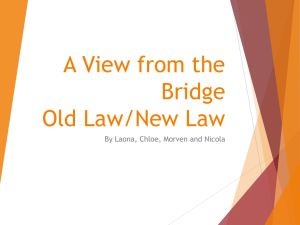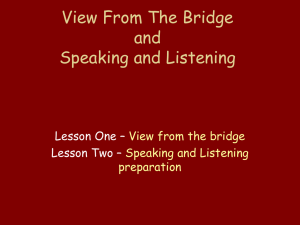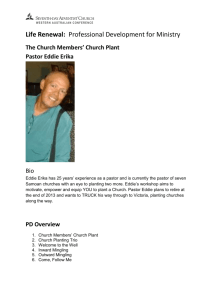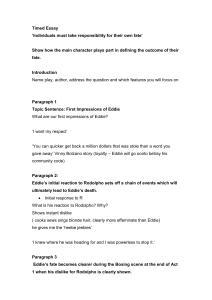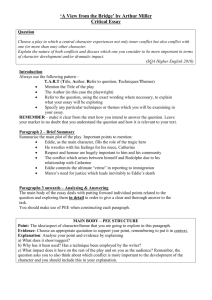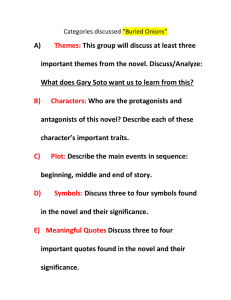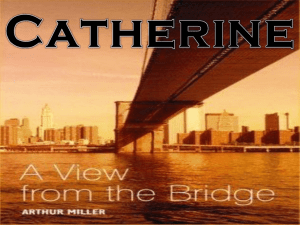A View from the Bridge
advertisement
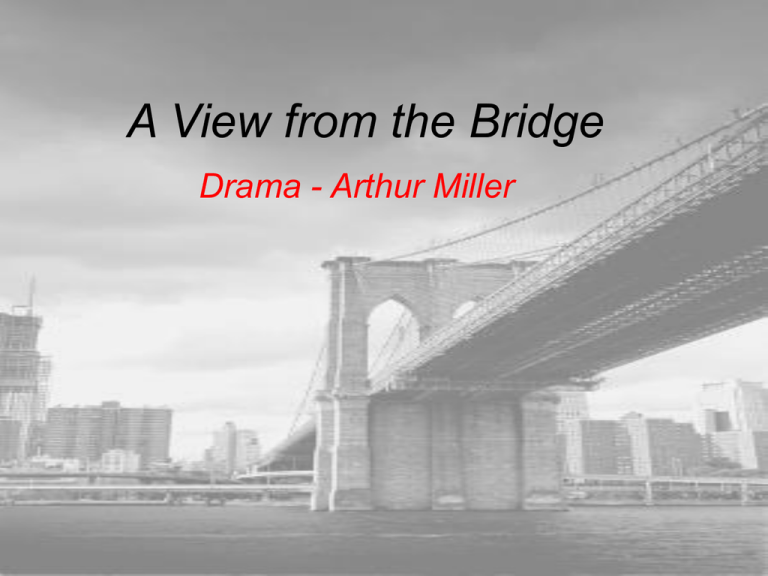
A View from the Bridge Drama - Arthur Miller Studying Drama Dialogue, monologue, soliloquy Aspects of staging: stage directions, lighting, set, music Context and Setting Symbolism Structure: exposition, climax, denouement Author’s Purpose – Theme(s) and Message Style and Tone Plot and Key Scenes Characterisation – Major/Minor, Key Relationships, Conflicts Stimulus and Development • Friend told of dream in which he was attracted to cousin – Miller suggested might mean he wanted incestuous relationship but he was horrified & refused to accept (Eddie/Alfieri) • Story of longshoreman who betrayed own relatives by going to Immigration – attempting to prevent marriage between one of the brothers & niece. Scorned & ostracized by community & disappeared (rumour one of brothers killed him) – Rodolpho/Catherine & Eddie’s reaction to relationship Red Hook and Longshoremen • In Brooklyn – slum area of New York (across Brooklyn Bridge) • One of first neighbourhoods to be settled – Dutch Settlers 1636 named after red soil & hook like shape • 1850 – one of busiest ports • Community of longshoremen & dockworkers – mostly Italian – developed late 19th century – most escaping poverty & seeking new life • Tough neighbourhood – Al Capone’s first home & scene of first crimes – got wound which inspired nickname ‘Scarface’ • Miller explored & researched neighbourhood – struck by complex Mafia power structure lurking beneath placid surface • 1950s Golden age of longshoremen community – 21000 living in row houses (built 1936) Symbolism of The Title What is the symbolism of the title – Brooklyn Bridge? • Symbolic of pathway of opportunity to Manhattan • Linkage between American & Italian cultures – important as Eddie has to battle between his Italian community values (loyalty & honour) and American Law & Order • Close to Red Hook – constant reminder of American opportunity & industry – what Rodolpho craves • Can view entire community below – seek greater abstract meaning from viewpoint • Alfieri symbolic of person on bridge looking upon community OR perhaps bridge himself – allowing people to cross into Manhattan & modern, intellectual American culture • Attempts to unite American law with Italian cultural practices – negotiate place between two • Narrates from present into past – same vantage point as one looking from bridge • As time passes – process events & see greater societal & moral implications it has for community as a whole • WE MUST BALANCE OUR OWN PERSONAL/INDIVIDUAL NEEDS & DESIRES WITH THOSE OF PEOPLE AROUND US - WIDER COMMUNITY The Greek Tragedy “I wanted to write a play that had the cleanliness… the clear line of some of the Greek tragedies. Meaning that we would be confronted with a situation that we would be told in effect what the ending was. The question was not what was going to happen, but how it was going to happen” Arthur Miller on the Dramatic Nature of the play. Greek Tragedy – Genre Features • Unity of time, place & action – a single location & situation • Tragic Hero (Eddie) – a character of noble stature & greatness, occupies a ‘high’ status position - must embody nobility & virtue as part of innate character • Not perfect – we must be able to identify – must see as essentially like us • Downfall partially his/her own fault = free choice. Triggered by error of judgement or character flaw: Hamartia = Tragic Flaw (Eddie’s self-interest & denial) • Punishment not wholly deserved – exceeds crime • Fall leads to some increase in self awareness, self-knowledge, discovery (Eddie’s final lines) • Arouses solemn emotion but offer catharsis - cleanse us of ‘unhealthy’ emotions (contribute to good health of community) Greek Chorus • Originally a group (up to 50 members) – several techniques: singing, dancing, narrating, acting • Provide background and summary information to help audience follow performance – comment on themes • Often express what the main characters cannot say – hidden fears, secrets • Alfieri (the Lawyer) performs role of Greek chorus - he has the view from the bridge - an elevated position of moral superiority: he has the ‘big picture - tells and controls the story in flashbacks, focusing on key scenes/moments – an important structural feature • Tells us what is going to happen - he sees the imminent danger but is powerless to stop it – reminds us of inevitability of ending Alfieri’s Opening Monologue What is revealed through Alfieri’s opening speech about the setting, situation and themes of the play? Pay particular attention to: The impression created of the Italian community The atmosphere of suspicion ‘justly shot by unjust men’ Use of imagery to describe Red Hook Changes over time Contrast between Alfieri’s usual cases and Eddie’s The universality and inevitability of Eddie’s fate Overview • Carbone family = Eddie (tragic hero), Beatrice (his wife), Catherine (Beatrice’s sister’s daughter) • At start, family are content, close . Eddie is dominant male, loving, well respected and overly protective • They are going to take in Beatrice’s cousins who are illegal immigrants looking for work • Rodolpho and Catherine begin to form a relationship which Eddie is jealous of • He tries to prevent the relationship and seeks advice from Alfieri (the lawyer) • When he does not get the advice he wants to hear, and is not successful in splitting the two up, he commits the ultimate betrayal • This leads to his family and the community turning against him • Marco seeks his revenge which leads to the inevitable tragic conclusion Act 1 – Part a: pp.1-7 Alfieri sets the scene and introduces Eddie’s story; Eddie arrives home with news of cousins’ arrival. How are the Carbone family presented at the start of the play? Consider them as individuals and as a family unit. Eddie Catherine Beatrice Eddie • • • • • Respected Domineering Paternal Protective Precious about Catherine • Worldly wise • Frank in his views/ opinions • Inquisitive • ‘a husky slightly overweight longshoreman’ • ‘you’re an angel’ – B • Symbols – ‘walkin’ wavy’ / ‘high heels’ • Acknowledges his roots Act 1 – Part b: pp.7-15 Catherine tells Eddie about her job opportunity; Eddie reminds Catherine & Beatrice not to speak about cousins and tells the story of Vinny Bolzano. QUESTIONS: List Eddie’s reasons and fears about Catherine’s job. What does Beatrice suggest is behind Eddie’s reluctance? Explain his reaction. What is the significance of Vinny Bolzano’s story being told? What signs are there in this section of the closeness between Eddie & Catherine? Consider stage directions and symbolic objects/ acts. How does Alfieri’s speech help establish Eddie’s character? Listening Focus Act 1 • Presentation of brothers • Eddie’s attitudes/ relationship with Rodolpho • Catherine & Rodolpho’s emerging relationship • Beatrice’s comments to Eddie & discussion with Catherine • Alfieri’s comments & discussion with Eddie • Boxing match/ confrontation Act 2 Scenic Unit 1 • Explain fully why this is such a pivotal scene: Relationship between Catherine & Rodolpho Relationship between Catherine & Eddie Symbolic importance of ‘the kiss’ Support your points with textual evidence. Pivotal • Consumation of Catherine & Rodolpho’s relationship • Catalyst for Eddie’s breaking point • Revelation of true (lustful?) nature of Eddie’s feelings for Catherine • First assertion of Catherine’s independence – rejection of Eddie The Kiss • Catherine? • Passion • Rodolpho? Possession Humiliation Act 2 – Scenic Unit 2 • How does Miller use Alfieri to convey the danger Eddie is in? • Who or what does Eddie betray when he phones immigration? • Summarise Beatrice’s view of the situation with Catherine. • What is revealed about Eddie’s attitudes during his argument with Beatrice? (‘wholly known’) Act 2 Scenic Unit 3 • Explain and analyse Eddie’s reaction to the news of Lipari’s two other boarders. • What is significant about the timing of the arrival of the Immigration Officers? Explain how Eddie reveals himself. • In terms of the drama why is it important that the arrests happen in public? Explain fully. • Analyse and summarise the differing views of justice discussed by Marco and Alfieri. The Ending • Catherine’s final assertion of her independence • What Eddie wants at the end – why Rodolpho won’t suffice • Beatrice’s view of situation • Eddie dying on his own knife • Eddie’s final words • Significance of Alfieri’s comments Character Notes • • • • • • Eddie Alfieri Beatrice Catherine Marco Rodolpho • • • • • • Personality Relationships Role in drama Key quotes Stage directions Relevance to theme Carousel Activity • Themes • Images/ Motifs/ Symbols • Turning Points/ Key Scenes • Dramatic Irony • Eddie • Catherine • Beatrice

